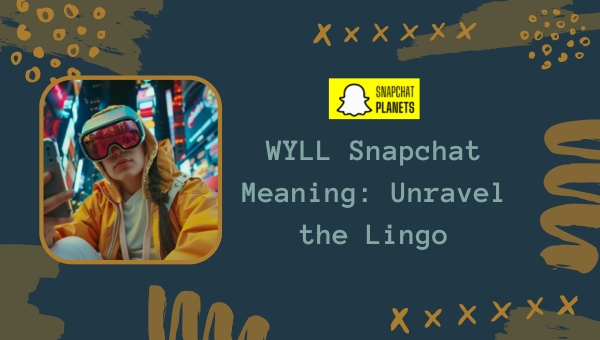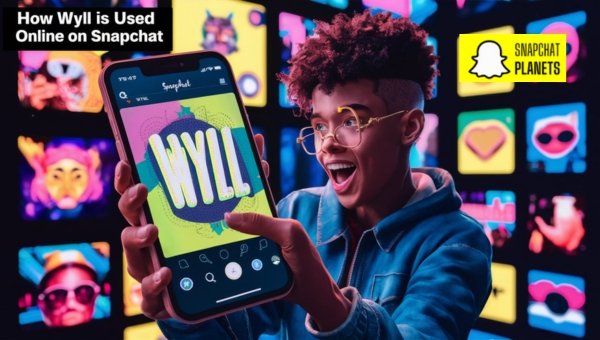
WYLL Snapchat Meaning: Unravel the Lingo
If you’ve been maneuvering the world of Snapchat, you might’ve come across the acronym WYLL, which stands for ‘What You Look Like?’ This casual prompt encourages friends to share glimpses of themselves, creating a more personal connection in a digital space.
As informal lingo evolves, understanding these terms can enhance your interactions and help you stay relevant. But what does this mean for the way we communicate online? Let’s explore the nuances behind ‘What You Look Like?’ and its impact on social dynamics.
Meaning of WYLL Snapchat
WYLL, which stands for ‘What You Look Like?’, is a popular way to ask for a visual representation of someone on Snapchat. This Snapchat slang has become a go-to phrase, especially among younger generations who thrive on quick and engaging digital communication.

When you use WYLL, you’re inviting someone to share a selfie, photo, or describe their appearance, which enhances the visual aspect of your conversations.
In a world where many interactions happen online, ‘What You Look Like?’ helps bridge the gap between virtual and real-life connections. It reflects a trend towards more informal and abbreviated language, making chats feel more personal and relatable.
As you engage with friends or new acquaintances, using ‘What You Look Like?’ can spark more dynamic conversations, especially when you haven’t met in person.
The rise of ‘What You Look Like?’ highlights how younger users prefer visual interactions, moving away from traditional text-based communication. This acronym illustrates the shift towards sharing images and videos, which are often more impactful than words alone.
Origins of WYLL Acronym
Originating on Snapchat, the ‘What You Look Like?’ acronym quickly became a popular way for users to ask about each other’s appearances in a casual and engaging manner. In the vibrant world of Snapchat lingo, WYLL means ‘What You Look Like,’ reflecting the platform’s focus on visual communication.
As social media surged in the early 2010s, users embraced the term WYLL as a shorthand for checking in on friends’ looks, especially when they hadn’t met in person.

This acronym captured the essence of the digital age, where quick and informal exchanges became the norm among younger generations.
The rise of ‘What You Look Like?’ coincided with a broader trend toward abbreviated language in online interactions, allowing users to get straight to the point without unnecessary words. By using WYLL, people could express curiosity about each other’s appearances while keeping the conversation light and breezy.
Ultimately, the emergence of WYLL highlights a cultural shift in how we communicate online. It’s a perfect example of how language evolves in response to new technology, making connections more accessible and fun within the fast-paced world of social media.
How WYLL Is Used Online
When you want to check in on a friend’s appearance, using ‘What You Look Like?’ in your message can spark a fun and engaging exchange. This acronym, which stands for ‘What You Look Like?’, is a popular way to request a quick photo or description on Snapchat.

By using WYLL, you invite your friends to share not only selfies but also pictures of their surroundings or even pets, making the conversation more lively and personal.
While ‘What You Look Like?’ is most commonly used on Snapchat, you’ll find it popping up on other social media platforms like Instagram and Twitter, keeping its meaning consistent across these channels.
This makes it easy to connect with friends no matter where you’re chatting. The acronym reflects a broader trend in digital communication, especially among younger users, who prefer quick and informal interactions.
Also Read: Snapchat Plus: Features & Cost
Responding to WYLL Messages
Responding to a WYLL message invites you to share a fun selfie or a quick description of your look, making the conversation more engaging.
If you want to respond to WYLL, consider sending a picture that captures your outfit or mood. Gen Z loves using Snapchat’s creative features like filters and stickers, which can make your response more lively and fun.
If you’re not comfortable sharing a photo, you can simply describe what you’re wearing or highlight a notable feature, like your hairstyle. This approach still fosters connection and keeps the conversation flowing. You might also want to ask the sender, ‘WYLL?’ in return, promoting a two-way exchange.
When responding to a WYLL message, think about expanding the conversation. You could share a Snap with music or discuss related topics, such as your plans for the day or an event you’re excited about. This not only deepens the interaction but also showcases your personality.
Ultimately, whether you choose to send a picture or describe your look, the key is to keep it light and fun while building your connection.
WYLL in Different Contexts
WYLL can vary in meaning depending on the context, inviting you to share not just your outfit but also your mood or current activities in a casual conversation. When someone sends you a message with WYLL, it can spark an engaging exchange that goes beyond just clothes.
Consider these scenarios where the use of WYLL comes into play:
- You’re feeling great and want to show off your new outfit.
- You’ve had a rough day, and you just want to share how you’re feeling.
- You’re excited about a fun activity and want to invite your friends to join.
- You’re hanging out and want to check in on a friend’s vibe.
In Snapchat, the meaning of WYLL often leans towards requesting visual updates, but it can also encourage deeper conversations. The flexibility of WYLL makes it a versatile tool for connecting with others, whether you’re discussing fashion, feelings, or fun plans.
Related Acronyms and Terms
Snapchat users frequently encounter various acronyms and terms that enhance their conversations and keep interactions lively. Understanding these digital shorthand expressions can make your chats more engaging.
For instance, ‘WYD‘ means ‘What You Doing?’ and is a casual way to check in on friends. If someone overshares, you might hear ‘TMI,’ which stands for ‘Too Much Information.’
Another popular acronym is ‘IYKYK,’ or ‘If You Know, You Know,’ often used to reference something that requires insider knowledge. When you want to set boundaries, you can use ‘DNI,’ meaning ‘Do Not Interact,’ to indicate that you’re not interested in engaging with certain conversations or people.
You might also come across ‘NBD,’ which stands for ‘No Big Deal,’ a way to downplay situations. If you ever find yourself confused about a term, don’t hesitate to ask your friends, “What does that mean?” They might even say, “Ask WYLL,” which encourages you to seek clarification on any acronym or expression.
Knowing these terms can help you navigate Snapchat conversations more effectively!
Also Read: Half Swipe on Snapchat: How to Do It?
Tips for Using WYLL
Using WYLL effectively involves keeping your tone casual and playful to match the fun vibe of your conversations. When you send a WYLL, you’re inviting someone to share a snapshot of their day, so make sure your response encourages that connection.
Here are some tips to help you shine next time you use WYLL:
- Don’t be afraid to get creative with your selfies!
- Use fun filters or stickers to add personality.
- If you’re not up for a photo, describe your outfit or surroundings.
- Ask the other person what they’re doing at the moment; it opens up the conversation.
When your friends see you’re using WYLL, they’ll often know you want to know more about their day too. This two-way sharing fosters deeper connections, making your chats more lively and personal.
Conclusion
WYLL has become a fun and engaging way to connect with friends on Snapchat and other platforms.
By asking ‘What You Look Like?’, you invite others to share a glimpse of their day or mood through selfies or descriptions.
Understanding this acronym helps you navigate online conversations more effectively.
Embrace WYLL as a tool for building relationships and enhancing communication, making your digital interactions feel more personal and vibrant.
So, next time you see it, don’t hesitate to respond!
